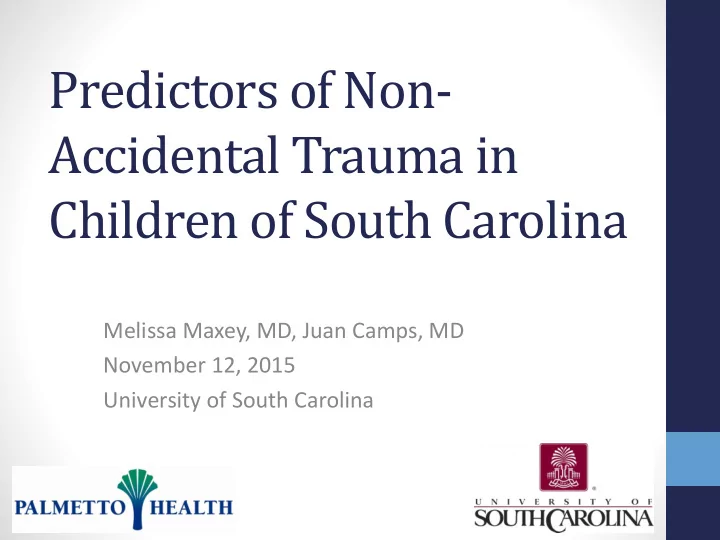

Predictors of Non- Accidental Trauma in Children of South Carolina Melissa Maxey, MD, Juan Camps, MD November 12, 2015 University of South Carolina
Acknowledgments • Juan Camps, MD • Natalie Brenders, MS III • Mandy Felder • Olga Rosa, MD • Martin Durkin, MD
Background • Non-accidental trauma (NAT) is a significant cause of pediatric morbidity and mortality. • At our institution, suspected cases of NAT are referred to a pediatric forensics committee for further evaluation.
Objectives • Evaluate all suspected cases of non-accidental trauma (NAT) and identify predictive factors for the cases determined to be probable NAT by the pediatric forensics committee.
Methods • Retrospective chart review of all cases referred to the pediatric forensic committee. • Admissions in the children’s hospital from 7/12/2008-3/26/2014 was performed.
Methods • 214 patients referred to the forensics committee • Information collected • Age • Gender • Insurance status • Body system • Diagnosis of failure to thrive • Emergency department visit within 6 months
Table 1: Baseline Characteristics by Ultimate Diagnosis Variable All Patients NAT Uncertain Not NAT Consult Age, yr. 1 0.58 (1.63) 0.54 (1.94) 0.51 (0.79) 1.32 (2.50) Age <1 yr. 2 126 (58.9) 58 (58.0) 49 (71.0) 19 (42.2) Male Gender 2 123 (57.5) 62 (62.0) 39 (56.5) 22 (48.9) RACE, 94 (43.9) 40 (40.0) 32 (46.4) 22 (48.9) Caucasian 2 AA 109 (50.9) 53 (53.0) 33 (47.8) 23 (51.1) Asian 1 (0.5) 0 (0.0) 1 (1.4) 0 (0.0) Biracial 10 (4.7) 7 (7.0) 3 (4.3) 0 (0.0) INSURANCE 78 (82.1) 48 (75.0) 31(68.9) 157 (77.0) Medicaid 2 Uninsured 4 (4.2) 7 (10.9) 5(11.1) 16(7.8) Private 13 (13.7) 9 (14.1) 9(20.0) 31 (15.2) 1Median (IQR) 2Count (%)
Results Variable Odds Ratio 95% Confidence P value Intervals Male Gender 2.33 [1.14, 4.74] 0.020 Genitalia 6.12 [1.57, 23.88] 0.009 Abdomen 5.77 [1.51, 21.97] 0.010 Chest 9.33 [3.13, 27.82] <0.001 Bones 2.01 [0.79, 5.11] 0.144 Cutaneous 5.30 [2.31, 12.15] <0.001 Head 3.37 [1.49, 7.63] 0.004 Failure to thrive 16.38 [4.70, 57.10] <0.001 ED visit within 6 2.22 [0.99, 4.98] 0.053 months
Discussion • No prediction based on insurance status, race, age • Each body system yielded a significant odds ratio • Highest likelihood NAT with chest and genitalia related injuries
Discussion • Diagnosis of failure to thrive as strongest predictor of NAT • Failure to thrive diagnosis can be difficult to make, often delayed • Early involvement of pediatrician during trauma admission
Limitations • Exclusion of accidental trauma patients • Retrospective • Small sample size • Criteria for forensic committee consultation • Accuracy and potential bias of forensic committee
Conclusions • Early recognition of NAT is important to reduce life- threatening injuries. • Our study identified multiple strong predictors of true versus not NAT within the population of suspected patients. • Future study may examine failure to thrive within a broader pediatric population.
Recommend
More recommend